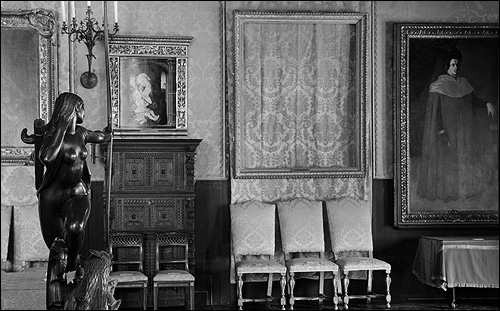

In the Isabella Stewart Gardner Art Museum hang empty frames gaping like wounds. Some consider it distasteful to leave the frames, deprived of their original content, while others maintain that the museum has taken the proper course of action, not altering the exhibits in any manner. The ideal way to dissolve this dispute, of course, would be to have the stolen artwork returned to the museum. But after 27 years, this resolution seems less and less likely.
Last Saturday marked the 27th anniversary of the Isabella Stewart Gardner Museum heist, in which two thieves disguised as Boston police officers broke into the museum and stole thirteen of the pieces on display. None of the pieces have made their way back to what Isabella Gardner had designated as their permanent resting homes in the gallery. The museum still offers a reward of up to five million dollars for information leading to the recovery of the pieces, still in good condition.
Until these pieces are returned, the frames and the respective spaces the objects once occupied are to remain empty. The woman who created the eponymous museum, Isabella Stewart Gardner, designated in her will monetary support for the museum along with the condition that the galleries would not be significantly altered from her original plans. Out of respect for her wishes, no new works have come to fill the voids in the museum.
Yet the absence of these pieces has opened space for new ones to form, however unconventional they may be.
In the Rotherwas room of the Mead Art Museum is the work of Kota Ezawa, a German artist educated in the United States and a current professor at the California College of the Arts, which depicts the artwork stolen from the Isabella Gardner Museum, accompanied with footage of the actual heist before entering. His works are illuminated with a glow box, which softens the somewhat harsh and planar minimalism of the actual piece. The hardware that illuminates the pieces constrasts with the antiquated architecture of the actual room itself, which was originally finished in 1611. In this space, the old and the new are forced together without an attempt to reconcile either, giving the viewer a strange sense of being within an anachronism. One cannot pinpoint a time period from which the architecture and the room suggest, giving a slight sensation of disorientation. The immediate instinct is to shrink from the room’s jarring cacophony.
Each piece is rendered in Ezawa’s minimalistic style, boiling a scene down to its base colors and most pertinent details while removing shadows and mid-tones. The shy light that glows from behind the comprehensive shards of color and shape gives it the feeling of a modern stained-glass window, which reinforces this sense of anachronism. Ezawa’s artwork commonly focuses on events such as the Isabella Gardner heist, including an animated video (which he considers a “moving painting”) of the O.J. Simpson trial and the assassinations of Presidents Lincoln and Kennedy.
However, Ezawa’s broad and simplified aesthetic in combination with his frequent use of technology renders these major historical events with a sleek, somewhat artificial and cartoonish exterior that makes it palatable for the eternally-consuming modern mind. The clean and appealing treatment of these topics slightly hollows out their weight and significance, which modern media, such as televised news, often does by selecting the broadest details or the most sensational aspects of a stories and packaging to their audience as the whole truth, often gutting it of nuance and complexity.
Ezawa’s work with its anachronisms may invoke some criticisms of modernity. However, it also allows us to understand artwork not as static, finished entities but as living and evolving thoughts and ideas. In doing so, Ezawa highlights a benefit of modernity, which continues to shape and improve our past efforts and gives new relevancy to the past. In the Rotherwas room, he depicts works of bygone eras and a historic heist that seems frozen in time, as it seems unlikely to ever have a resolution or closure. His modern aesthetic, in which he renders both the objects and evokes the event of the heist, gives a new life, a new meaning and a new relationship between the viewer and the artist that they didn’t have before and that the original artist hadn’t intended.
Perhaps this is a broader demonstration that, as Da Vinci once said, “Artwork is never finished, only abandoned.” Even after the painter decides upon the last brush stroke they put on the canvas, the artwork continues to evolve. Audiences interpret them in different ways either by the change in the piece’s location or a change in the views of society. Age or repairs alter the physical appearance. Other artists respond to the artwork with their own, changing the piece from a monologue to a dialogue. Other artists may take the concept of a piece, elements of a work or the whole piece itself and alter it to make a new statement with their predecessor’s work as a spring board. Ezawa’s show is a powerful demonstration of this immortal evolution of artwork, as he gives new life and a new aesthetic to pieces that some may consider static or finished, or without influence due to their disappearance. Ezawa brings these pieces and this event to the present moment to show its continued relevance and honors the evolution of art that happens long after a piece is abandoned or even stolen.